 |
| |
South Wing: Mississippi - |
| Thegolden age of radio - part 2 - the years 1941 - 1950 |
| WE INTERRUPTTHIS PROGRAM TO BRING YOU A SPECIAL NEWS BULLETIN: THE JAPANESE HAVE ATTACKED PEARL HARBOR, HAWAII BY AIR; PRESIDENT ROOSEVELTHAS JUST ANNOUNCED. THE ATTACK ALSO WAS MADE ON ALL NAVAL AND MILITARY ACTIVITIESON THE PRINCIPLE ISLAND OF OAHU. The unthinkable has happened: Japan - put into a terribly desperate positionby the boycotts and embargoes on oil placed on it by the United States -suddenly and with great success - lashes out and strikes the United Statesterritory of Hawaii - and the Pacific Fleet stationed there. People whoheard that announcement on the radio that Sunday in December often say itwas one of the most profound experiences of their life; the impact of thosewords hit almost as hard as a physical blow. Some say that the blunt announcementactually left them feeling ill. What was clear was that radio would foreverchange the public's views of world affairs and events: what wasn't immediatelyclear was just how large a role radio would play in the execution and outcomeof the war just announced. |
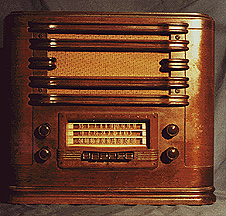 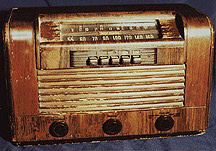 |
All of those radios Americans had been buying were tuned in to the networknews feeds as President Roosevelt addressed a joint session of congress- and via live radio - the American Nation - and the World. His indignationrang out in words that have become as famous as the deed they described:"Yesterday, December 7, 1941 a date which will live in infamy.The United States of America was suddenly and deliberately attacked by Navaland Air Forces of the Empire of Japan"Americans had bought their radios with the expectation of being entertained.Now those radios were messengers of political and social upheaval: propaganda- though in it's infancy - was off to a flying start. Hitler adored theidea of both terrorizing potential victims and gloating over conquered landswith his high-powered radio broadcasts from Berlin. Not to be outdone -Mussolini made more than a few "made for Radio" speeches. Butit was two voices of confidence and righteous indignation that provideda guiding spirit - Churchill with his unflagging confidence in his Nationand it's people; and Roosevelt's fatherly talks - which became known ashis "Fire-side Chats". The Radio on the left is a 1941 Sears /SilvertoneModel 7038 with mechanical push-button tuning (i.e. pushing the buttonsliterally moves the pointer up and down the dial to the desired station);the radio on the right is a 1941 RCA model 26X4 with electrical push-buttontuning (i.e. the push buttons were just switches - the pointer wasn't usedin the push-button mode). |
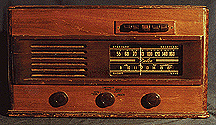 As America went to War - all available production facilities were convertedto War Materials Production. Manufacture of civilian goods virtually ceased- and as a result - became difficult to find "new" replacements.This was true of everything from Cars, appliances (including radios), evenclothing got scarce at times. Rationing was the order of the day. This 1942Delco (General Motors, Corp. ) R-1212 is rare - not that it's a specialradio - just that fact that in 1942 - it's lucky to have been made at all.By the end of 1942 - all civilian radio production had been converted toWar production - and new radios - just weren't available. In the North wing- there is a Zenith 5F233 that started out life as a battery set - and becausenew sets couldn't be found - the set was converted to AC Mains powered andgiven to a young man as a Christmas Present. As America went to War - all available production facilities were convertedto War Materials Production. Manufacture of civilian goods virtually ceased- and as a result - became difficult to find "new" replacements.This was true of everything from Cars, appliances (including radios), evenclothing got scarce at times. Rationing was the order of the day. This 1942Delco (General Motors, Corp. ) R-1212 is rare - not that it's a specialradio - just that fact that in 1942 - it's lucky to have been made at all.By the end of 1942 - all civilian radio production had been converted toWar production - and new radios - just weren't available. In the North wing- there is a Zenith 5F233 that started out life as a battery set - and becausenew sets couldn't be found - the set was converted to AC Mains powered andgiven to a young man as a Christmas Present. |
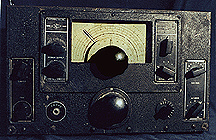 Many of the first radios into war were civilian radios converted for militaryuse. The U.S. Navy needed a "super-snoop" radio - but one theenemy couldn't hear. Almost all modern radios use a design that mixes the in-comingradio signal with a local signal. The Navy had long before discovered thatthe local oscillator in these radios could be detected at a fairly largedistance - and had learned that they could find ships by listening for theirreceivers - radio silence indeed!... As a bonus - since the signal pickedup was "tracking" the radio signal the enemy radio was listeningto - the Navy could not only find the enemy - but usually figure out whathe was listening to! The Navy reasoned that if they had figured this out- the enemy might stumble upon it as well... so they ordered a Radio designedto "hear" but not be "heard"! The National NC-120 -a civilian radio - was outfitted with an extra heavy - copper plated chassis- lots of RF gaskets, and an additional RF amp / isolation stage built ina "back porch" chassis bolted to the back of the main chassis.All of this careful work resulted in a radio that radiated no more than400picoWatts into the antenna circuit - and none detectable around the setitself. The RAO-6 can be powered by 110VAC or batteries (6V 3.5A & 180V60ma.). Many of the first radios into war were civilian radios converted for militaryuse. The U.S. Navy needed a "super-snoop" radio - but one theenemy couldn't hear. Almost all modern radios use a design that mixes the in-comingradio signal with a local signal. The Navy had long before discovered thatthe local oscillator in these radios could be detected at a fairly largedistance - and had learned that they could find ships by listening for theirreceivers - radio silence indeed!... As a bonus - since the signal pickedup was "tracking" the radio signal the enemy radio was listeningto - the Navy could not only find the enemy - but usually figure out whathe was listening to! The Navy reasoned that if they had figured this out- the enemy might stumble upon it as well... so they ordered a Radio designedto "hear" but not be "heard"! The National NC-120 -a civilian radio - was outfitted with an extra heavy - copper plated chassis- lots of RF gaskets, and an additional RF amp / isolation stage built ina "back porch" chassis bolted to the back of the main chassis.All of this careful work resulted in a radio that radiated no more than400picoWatts into the antenna circuit - and none detectable around the setitself. The RAO-6 can be powered by 110VAC or batteries (6V 3.5A & 180V60ma.). |
 The SCR-284A / BC654 Multi-Configuration Radio Set:
The BC-654 is a receiver / transmitter which covers 3800KC to 5800KC andis rated at 17 Watts CW, 5 Watts AM Phone - although 25W CW and 11W Phoneare typical. The Radio Set comes in three basic configurations - Field RadioSet, Vehicular Radio Set (as displayed here) and Command Radio Set. Thefirst two were used during WWII; all three during Korea. In all configurations,the receiver / transmitter are identical - the differences come in how theunit is installed and powered. As a field radio, the unit sets on four legs,the receiver is powered by a battery (BA-43) and the transmitter by a hand-crankedgenerator. The set packed up into three 55 pound back-packs that the radiomanand two assistants would carry. Once in operation, the radioman operatedthe set, while the two assistants took turns cranking the generator andstanding guard. As a vehicular set the unit sits on a large stand whichalso holds a 6/12V dynamotor (PE-103) to power the transmitter -- the receiveruses a vibrator supply (PE-104). As a command set, the unit is usually seton a table, and powered by a two-cycle 3600RPM 1 horse gas generator. That brings us to our BC-654 - serial number 56089, manufactured in August,1943. Whether it ever saw combat is doubtful - this unit looks as it didthe day it was made. Complete with all spares and most of it's accessories,this radio is ready for service. The manual, TM 11-275 dated 24 January,1944. The two mannequins, (only one shown in this picture) are in genuinefield issue uniforms with correct insignia... Fred (shown) stands whileSammy (not shown) sits at the radio.  Another radio with a long and proud history is the BC-348 (and it's14Volt cousin the BC-224). Manufactured over a period of 10 years (1945-1957)the BC-348 enjoys one of the longest service records of any WWII designgear. Designed primarily for aircraft service - the BC-348 has many veryattractive attributes: Extremely stable; very selective yet easy to tune(200:1 tuning ratio); very sensitive (S=S+N/N > 10db = 5uv). Used inthe late years of WWII in virtually all bombers (including the Enola Gay)the BC-348 served through Korea as well. Another radio with a long and proud history is the BC-348 (and it's14Volt cousin the BC-224). Manufactured over a period of 10 years (1945-1957)the BC-348 enjoys one of the longest service records of any WWII designgear. Designed primarily for aircraft service - the BC-348 has many veryattractive attributes: Extremely stable; very selective yet easy to tune(200:1 tuning ratio); very sensitive (S=S+N/N > 10db = 5uv). Used inthe late years of WWII in virtually all bombers (including the Enola Gay)the BC-348 served through Korea as well. |
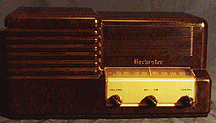 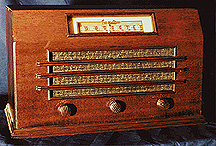 |
| With the surrender of Japan, the mighty manufacturing capacity of theUnited States turned it's attention to it's favorite pastime: separatingshoppers from their dollars. And with all the pent-up demand - Americanswere ready to buy! In 1941 - the last full year before the war - Americansbought some 13 Million radios. In the year after the war - in spite of thefact that most of the products offered were just re-hashed 1942 models -Americans bought some 12 million sets. By 1947 - the manufacturers had re-tooled- truly new sets were rolling off the lines - and Americans bought some16 million radio sets. These sets from 1946 are typical of post war tablesets: the Brewster model 9-1084 (left); and the LearRadio model 6615 (right). |
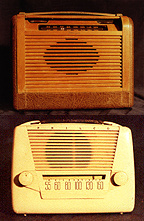 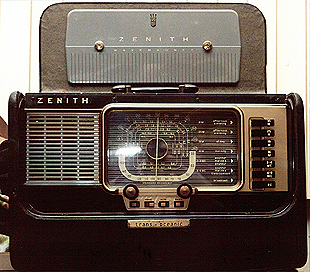 Another bright spot right after the war was in portable radios: miniaturetubes developed for military use now found new purpose in a new breed ofportable radios - These Philcos are typical (1946 model 46-350 top left;1949 model 49-601 bottom left) of post-war "inexpensive" portables...The H-500 (1951) transoceanic fills in the "luxury class" of post-warportables. Another bright spot right after the war was in portable radios: miniaturetubes developed for military use now found new purpose in a new breed ofportable radios - These Philcos are typical (1946 model 46-350 top left;1949 model 49-601 bottom left) of post-war "inexpensive" portables...The H-500 (1951) transoceanic fills in the "luxury class" of post-warportables. |
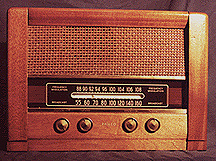 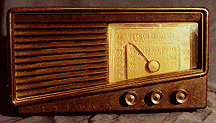 As the "Golden Age" of Radio faded into the 50's and radiobecame radio with pictures - radio manufacturers were faced with tryingto guess what the public wanted (which was cheap and flashy) but old habitsare hard to break - and many manufacturers had good success with "finecraftsmanship" and the "warmth" of wood. But the handwritingwas on the wall - the public wanted flashy - modern - colorful - and cheap.Two models from Philco from 1949 show just how different these two directionsare (Philco 49-909 left; Philco 49-905 right). Both AM-FM; both good radios- but the one on the right is half the price of the other -- guess whichsold the most! As the "Golden Age" of Radio faded into the 50's and radiobecame radio with pictures - radio manufacturers were faced with tryingto guess what the public wanted (which was cheap and flashy) but old habitsare hard to break - and many manufacturers had good success with "finecraftsmanship" and the "warmth" of wood. But the handwritingwas on the wall - the public wanted flashy - modern - colorful - and cheap.Two models from Philco from 1949 show just how different these two directionsare (Philco 49-909 left; Philco 49-905 right). Both AM-FM; both good radios- but the one on the right is half the price of the other -- guess whichsold the most! |
| |
| Express to the West Wing: The tour continues... |
| |
| Returnto the Lobby |
| Copyright © 1996, The Mississippi HistoricalRadio and Broadcasting Society. |